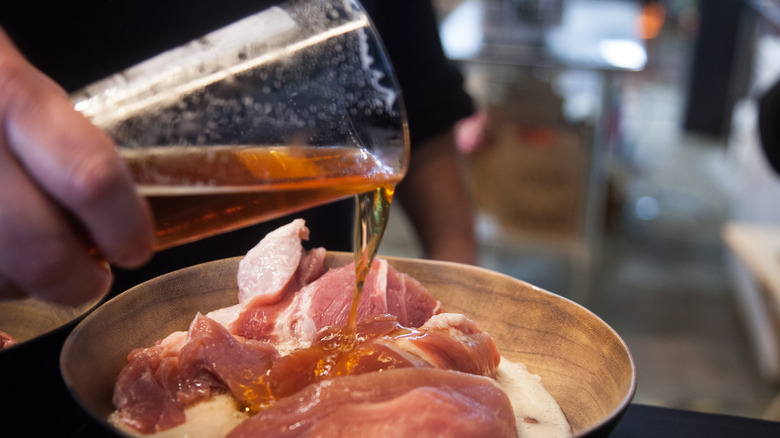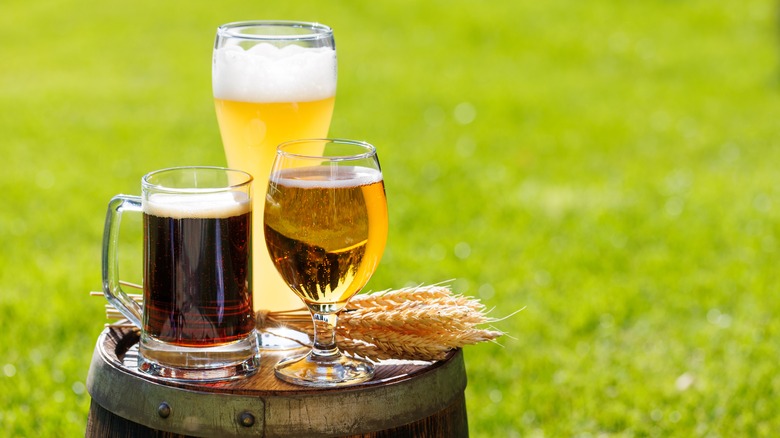Chef Kwame Onwuachi's Pro Tips For Cooking With Beer
It's no secret that wine is a supreme flavor-booster when added to all sorts of dishes, tenderizing meats and adding juicy, acidic notes (just be sure to let the alcohol cook off properly). But it's not the only alcohol worth using in your kitchen: Former "Top Chef" contestant and James Beard Award-winner Kwame Onwuachi is a big advocate for pouring a little beer into your sauce or braise to deepen the flavor. In particular, he's a fan of using heavier beers like Guinness to add depth and boost the spiciness of his Afro-Caribbean cuisine, which he serves at New York City restaurant Tatiana. But beer can work in a broad range of dishes beyond Onwuachi's focal points, too.
"I like to use it to enhance the flavor of things," Onwuachi says. "Whether it's a braise, marinade or brine, or enriching something that has more of a blank canvas — beer can be a great thing to incorporate."
While wine can add bright, acidic notes to food, beer tends to add a more earthy layer, especially in dishes like stews or chili con carne. If you use it with meats — for example, in a marinade — it can also tenderize your meat similar to how wine does, especially if it's a tough cut. It can also be used in ways that wine can't: Its heavy carbonation and foaminess mean it can make batters light and fluffy, for example, for fish and chips.
How exactly to use beer in the kitchen
When it comes to beer, Kwame Onwuachi doesn't put firm rules on how you can use it in your cooking. In fact, according to him, you could treat it like a kitchen staple.
"Beer will only add flavor, so the effects are all positive. There's no 'wrong' way, really, to go about it," he says. "You can use it to finish a sauce, or as a marinade for meat. My rule of thumb would be to think of it as versatile of an ingredient as vinegar, minus the acid."
Of course, just as with vinegar, you still want to use beer judiciously so it doesn't overpower other flavors. If you're using it in a marinade, you'll probably be pretty restrained, using as little as a half-cup. Recipes like chili are a bit more flexible, often calling for a full 12-ounce bottle. For beer batter, follow a recipe carefully: Add too much, and it'll end up watery and won't do the trick. But don't stress too much, says Onwuachi — if the beer tastes good out of the bottle, it'll likely work well in a dish.
"Remember to not be afraid," he says. "The liquid is already so delicious, so whatever you're working on is going to turn out well."
Using different beer types in cooking
Of course, there's a huge variety of both light and dark beer types out there, so it's worth being aware of which ones work best in which scenarios. Some general advice is to pair lighter beers with light dishes: A Pilsner or a wheat beer works well with chicken or fish, and a bubbly lager does well in a beer batter.
Correspondingly, heavier dishes like stews and braises can handle darker, heavier beers like porters, stouts, and ales. They also work better with darker meats like lamb or beef. In saucy dishes, switch out some of the water or broth for beer. With a slight sweetness, stouts can work well in a gravy or a glaze for meat. Malty dark beers can even work for baking. Guinness bread is a classic Irish recipe, but the beer can even add a nutty, malty dimension to sweet treats like cakes, and pairs especially well with chocolate.
Finally, be careful with hoppy beers like IPAs. As the beer reduces, it tends to inject noticeably bitter notes into your dish. For this reason, IPAs are generally not recommended so much for culinary use; if you must use them, do it sparingly.
For real-life examples of dishes that are cooked with beer, stop by an epic block party hosted by Kwame Onwuachi and Guinness on Saturday August 24. Expect New York-inspired dishes and plenty of cold Guinness — RSVP on Guinness' website.


